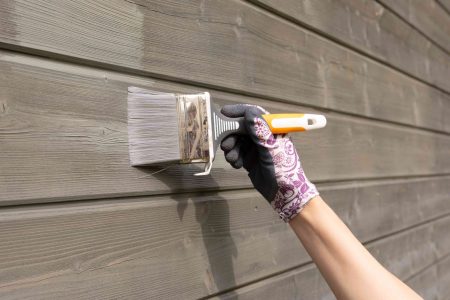Breaking concrete is never an easy project. While it is possible to rent a jackhammer from home improvement stores or rental yards, this can get expensive if the project drags on. Not only that, wielding the jackhammer itself can be a tough, physically demanding task. Instead, many homeowners choose to break their concrete in a more leisurely and less expensive fashion, using a sledgehammer.
The trick to breaking up concrete is to dig underneath the slab before hitting it with the hammer. Undermining the concrete eliminates its external support, making the material much more vulnerable to cracking through and breaking off.
With small slabs of concrete, such as patio squares or air conditioner pads, you can also have one person pry up the slab a few inches, using a demolition bar, while another person strikes the slab with the hammer. Prying up the slab has the same effect as digging underneath it. Alternatively, you can pry up the slab and shove a rock or piece of lumber under the slab to hold it up above the soil.
Warning
Call 8-1-1, the national “Call Before You Dig” hotline, to have all underground utility lines marked in your work area before you start the project. It’s not uncommon for electrical, water, and gas lines to run under concrete structures.
Need more help? Talk to a contractor near you
Our partners can help you compare quotes from top-rated professionals near you
Get a Quote
What You’ll Need
Equipment / Tools
- Eye protection
- Work gloves
- Shovel
- Pickax or mattock
- Garden hose
- 8- or 10-pound sledgehammer
- Pry bar
- Hand truck
Materials
- Water to spray on concrete
Instructions
-
Dig Under the Concrete
Dig out the soil, gravel, or other material from under the concrete, using a shovel and a pickax or mattock. Dig about 1 foot inward from the slab’s edge, making a gap of 1 inch or so; the void does not need to be deep. A pickax or mattock is handy for cutting through roots, breaking up rock or shale, and scraping material out from under the slab.
-
Strike the Concrete
Lightly sprinkle the concrete with water to minimize dust. Grasp the sledgehammer handle with your dominant hand close to the head and your other hand toward the end of the handle. Use an arching motion with plenty of leg action to lift the hammer as high as possible but not directly over your head, and then let it fall as you slide the dominant hand down the handle. Strike the concrete along the edge of the void you dug underneath, as though you are breaking something over the edge of a table. Repeat as needed, striking in the same place each time until the concrete breaks.
-
Pry Off Stubborn Pieces
Use a pry bar or crow bar to open cracks and separate pieces that are resistant to falling away. Force the flat end of the bar into the crack. Wiggle it back and forth until it is at least 1/2 inch into the crack. Pry back until you can get your gloved fingers in to pull away the piece.
-
Move the Concrete Chunks With a Hand Truck
Use a hand truck or dolly to move large chunks of concrete. A hand truck is better than a wheelbarrow because you only have to lift the chunk of concrete an inch or two to get it onto the truck. Lift the concrete pieces carefully, using your legs and keeping the weight close to your body. Truck the pieces to your collection or disposal area.
Disposing of Broken Concrete
Never dispose of concrete in your regular garbage service. Most collectors will not take it. You can arrange for a dumpster through a trash pickup service, but be sure to tell them that you need it for concrete, and find out how much you can fill the dumpster. Often a dumpster filled with masonry materials, which are extremely heavy, should not exceed the maximum tonnage set by the service company.
On the other hand, broken concrete does not have to be sent to the landfill. There are plenty of uses for it around the yard:
- Flip large pieces of concrete over, powerwash them, and turn them into a low-cost stone-look pathway.
- Stack the concrete pieces up and create a short garden wall.
- Make short retaining walls.
- Stack the pieces in a circle to make a fire pit.
- Use the pieces as edging for a pond to hold down the pond liner.
- Use the small rubble as French drain material.
- Use the concrete as fill material when you want to build up an area of your yard.
Tips for Breaking Concrete by Hand
If you don’t pace yourself, this can quickly turn from a moderately challenging project to a grueling task that you may have to give up on and hire out. Work slow and steady, and keep a few expert tips in mind:
- It is critical to wear eye protection to protect your eyes from flying shards of concrete, grit, and sand.
- Concrete that is no more than 4 inches thick (typical for a walkway or patio) is a perfect candidate for manual demolition. Beyond 4 inches, the work becomes exponentially more difficult.
- Breaking up concrete is highly strenuous work. Take frequent breaks and keep yourself well-hydrated.
- To break off large pieces, make a series of blows in a line to create a stress crack, then strike in the middle of the area you want to remove to break the concrete along the line.
- The size of the chunks you remove is limited by your ability to lift and dispose of the concrete. If you cannot lift heavy loads, break the concrete up into small pieces of rubble.
- You can use a grinder and masonry wheel to score concrete about 1/4-inch deep where you’d like it to break to guide your work. A cold chisel (for masonry) can also be used for the scoring.
Read the full article here














